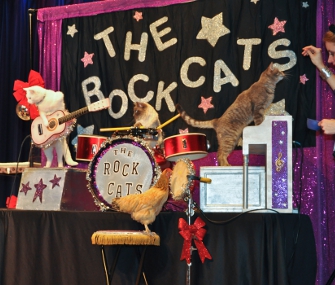I Work With Animals: My Life as a Cat Circus Ringleader
Published on April 03, 2012

Samantha Martin takes the phrase “let’s get the show on the road” literally.
When her cats aren’t posing for kitty litter labels or cat toy packaging, Martin travels the country putting on shows with her talented troupe of felines who play instruments and perform circus tricks as The Acro-Cats.
The journey to making a full-time living with her pet house cats — who, she says, “have more furniture than I do” — was not without its bumps, including a failed attempt working with ferrets.
But now her audiences come out en masse to watch her skilled cats take to the stage — and even pick up some simple techniques from Martin for training their own circus-worthy felines back at home.
Q. How does your show differ from a traditional circus?
A. Martin: "There are some similarities because they are doing circus-style tricks. They roll balls, walk on a high wire, climb ladders, perform hoop jumps and more. One cat will jump on a medicine ball, balance on it and roll it. But the difference is that it’s all free will. If they want to jump through a hoop, they do, but if they’re not feeling it that performance, they don’t. The show has two parts: The Acro-Cats do the tricks, and The Rock Cats play guitars, percussion and keyboards with a chicken who plays the cymbal and the tambourine."
Q. How do you get them all to shows hundreds of miles from home?
A. "I have a 33-foot RV that has been modified, with a space above the cab that I call Kitty City. The band members don’t like the rest of the cats, so they have their own quarters. We actually renegotiated their contracts — the band cats used to be Acro-Cats, but they decided that they were just going to be in the band."
Q. The band cats sound a lot like human musicians. Are they divas?
A. "They are like a real band. They tolerate each other on stage as long as they stay within their parameters. But when drummer Dakota’s tail invades Pinky the guitarist’s territory, Pinky will get upset."
Q. What were you doing before you launched this show?
A. "I started my company with a group of rats that I'd trained, but I discovered that I couldn’t make a living on just rats. So I expanded into ferrets, chickens, a chinchilla and other small exotics and did an education show with them for years. But I was losing money, and I wasn’t doing much training, which is what I love. Then I got Tuna, a brilliant and confident cat who is the inspiration for the show."
Q. How many cats are in your circus, and how do you train them?

A. "There are 13 cats in the show, but if I have fosters, I will sometimes put them in the show, too. I do a clicker-training demonstration in the show, and the first thing that I do when I get a foster cat is whistle train them to go in their crate. I also clicker train them all to do something cute. It gives a foster cat an edge up on a cat who hasn’t been trained.
Training can also help detect health problems. The band uses my kitchen table to practice. Whenever I cook, the band thinks it's training time, and they start playing. Pinky never misses a band practice, but she did one day. I offered her a free treat, but she didn’t want it, so I took her to the vet and it turned out that she had some bug. If we didn’t have our routine, I might not have noticed."
Q. Are there other benefits to training a cat?
A. "Cats need mental stimulation and the ability to bond with their human. Cats wind up in shelters more than dogs because people have a different relationship with cats — but you can have a dog-type relationship with your kitty. Clicker training is a communication tool that works like a common language once a cat catches on to the game. Cats left alone get bored because they don’t have a job. My cats have a job. Everybody’s cat should have a job."
Q. What's the easiest trick to teach a cat?
A. "Jumping through a hoop. You just need a small hula hoop or an embroidery hoop. Put two chairs close together, and the cat just has to walk from one chair to the other and through the hoop to get a treat. The clicker is a marker. Click it when the cat is going through the hoop and your kitty's brain will process, ‘I have to get through that circle to get the food.’ You then move the chairs two inches apart, then four and then eight inches. There's a point when your cat has that light bulb realization. It’s a really neat moment."
For more tales of what it's like to work with animals, check out these other Vetstreet-exclusive stories.





